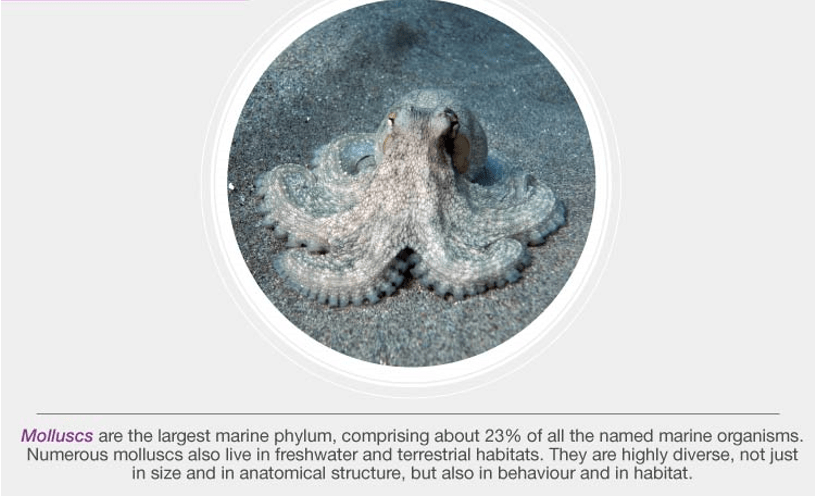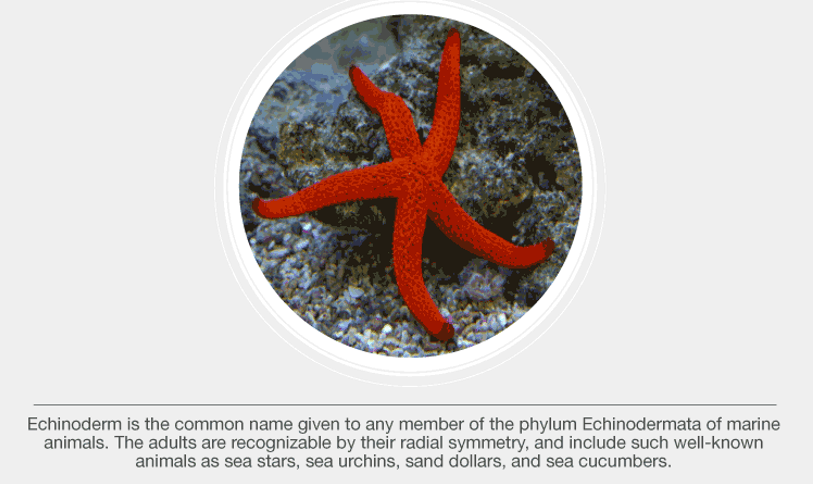Phylum – Mollusca, Echinodermata & Protochordata - NEET PDF Download
Mollusca
The animals belonging to the phylum Mollusca have soft-bodies, triploblastic and bilaterally symmetrical and coelomate. The study of Mollusca is called Malacology. They are sluggish invertebrates, with a thin fleshy envelope or mantle covering the visceral organs. The term Mollusca was derived from the term given by Aristotle to cuttlefish. Mollusc means soft.
These organisms are found in the terrestrial as well as in deep seas. Their size ranges from microscopic organisms to organisms 20 metres long. They play a very important role in the lives of humans. They are a source of jewellery as well as food. Natural pearls are formed within these molluscs. The bivalve molluscs are used as bioindicators in the marine and freshwater environments. But few of them such as snails and slugs are pests.
Mollusca Characteristics
The organisms belonging to phylum Mollusca exhibit the following characteristics:
- They are mostly found in marine and freshwater. Very few are terrestrial and found in moist soil.
- They exhibit organ system level of organization.
- Their body has a cavity.
- The body is divided into head, visceral mass, muscular foot and mantle.
- The head comprises of tentacles and compound eyes.
- The body is covered by a calcareous shell.
- The muscular foot helps in locomotion.
- They have a well-developed digestive system, the radula is the rasping organ for feeding.
- They respire through the general body surface, gills or pulmonary sac.
- The blood circulates through the open circulatory system.
- They have a pair of metanephridia that helps in excretion.
- The nervous system consists of number of paired ganglia and nerves.
- The tentacles, eyes, osphradium, and statocysts act as the sensory organs.
- The sexes are separate in most of the molluscs but some species are hermaphrodites. Fertilization may be external or internal.
- They are generally oviparous with indirect development.
Classification of Mollusca
Following are the classification of Mollusca:
➤ Aplacophora or Solenogasters
- The body is cylindrical or bilaterally symmetrical.
- These are devoid of the head, shell, mantel, nephridia, and foot.
- The digestive ceca is absent.
- Spicule-bearing cuticle covers the body.
- It contains a dorsal longitudinal keel or crest.
- E.g. Neomenia, Chaetoderma
➤ Monoplacophora
- The body is bilaterally symmetrical.
- The head is devoid of eyes and tentacles.
- Respiration occurs through gills which are externally located.
- The nitrogenous waste is excreted out through nephridia.
- E.g. Neopilina
➤ Polyplacophora
- Their body is dorsoventrally flattened like a leaf, and are bilaterally symmetrical.
- The shell is composed of 8 longitudinal plates.
- They have a well-developed radula.
- The ventral foot is flat.
- E.g. Chiton, Cryptochiton.
➤ Gastropoda
- They are found either on land or in fresh and marine water.
- The head bears tentacles, eyes, and a mouth.
- The shell is spiral in shape.
- The foot is flat and large.
- E.g. Haliotis, Pila
➤ Scaphopoda
- Found in the marine environment.
- The eyes and tentacles are absent.
- The foot is reduced.
- The body is bilaterally symmetrical.
➤ Pelecypoda
- They reside in aquatic habitats.
- The body is bilaterally symmetrical and compressed laterally.
- The body has no distinct head.
- They usually burrow in mud and sand.
- E.g. Mussels, Unio
➤ Cephalopoda
- They are mostly found in the marine environment.
- The shell is either external, internal, or not present at all.
- They have separate sexes.
- The development is direct.
- E.g. Octopus, Spirula
➤ Mollusca Examples
- Following are a few examples of the animals belonging to phylum Mollusca:
- Pila (Apple snail)
- Limax (Slug)
- Unio (Freshwater mussel)
- Turbinella (Shankha)
- Helix (Garden snail)
- Octopus (Devilfish)
- Loligo (Squid)
➤ Key Points on Mollusca
- Phylum Mollusca is the second largest phylum.
- A few molluscs such as Unio possess green glands which mimic the liver in vertebrates.
- They possess osphradia to test the chemical nature of water.
- The statocysts maintain body equilibrium.
- Octopus has 8 arms and contains no shell. They also possess ink glands for protection.
- The blood is blue or green in colour due to the presence of a pigment containing copper called haemocyanin.
- They possess a myogenic heart.
Here is an overview of the phylum Mollusca that includes the classification of Mollusca, Mollusca characteristics, and Mollusca examples.
Echinodermata

The organisms belonging to the phylum Echinodermata are exclusively marine. Till date, there have been no traces of any terrestrial or freshwater Echinoderms. These are multicellular organisms with well-developed organ systems. All the animals belonging to this phylum share the same characteristics features. They are colourful organisms with unique shapes.
They are ecologically and geologically very important. The Echinoderms are found in sea-depths as well as in the intertidal zones. An interesting feature of the phylum Echinodermata is that all the organisms belonging to this phylum are marine. None of the organisms is freshwater or marine.
The water vascular system present in echinoderms accounts for gaseous exchange, circulation of nutrients and waste elimination.
Characteristics of Echinodermata
- They have a star-like appearance and are spherical or elongated.
- They are exclusively marine animals.
- The organisms are spiny-skinned.
- They exhibit organ level of organization.
- They are triploblastic and have a coelomic cavity.
- The skeleton is made up of calcium carbonate.
- They have an open circulatory system.
- They respire through gills or cloacal respiratory tree.
- They have a simple radial nervous system and the excretory system are absent.
- The body is unsegmented with no distinct head. The mouth is present on the ventral side while the anus is on the dorsal side.
- The tube feet aids in locomotion.
- They reproduce sexually through gametic fusion and asexually through regeneration. Fertilization is external.
- The development is indirect.
- They possess the power of regeneration.
- They have poorly developed sense organs. These include chemoreceptors, tactile organs, terminal tentacles, etc.
Classification of Echinodermata
➤ Asteroidea
- They have a flattened, star-shaped body with five arms.
- They have tube feet with suckers.
- They respire through papulae.
- The body comprises of calcareous plates and movable spines.
- Pedicellaria is present.
- Eg., Asterias, Zoroaster
➤ Ophiuroidea
- The body is flat with pentamerous discs.
- The tube feet are devoid of suckers.
- They respire through Bursae.
- The long arms are demarcated from the central disc.
- Eg., Ophiderma, Amphuria
➤ Echinoidea
- The body is hemispherical.
- The tube feet contains suckers.
- The body does not have arms.
- The body has a compact skeleton and movable spines.
- Eg., Echinus, Cidaris
➤ Holothuroidea
- The body is long and cylindrical.
- The arms, spines, and pedicellariae are absent.
- They respire through the cloacal respiratory tree.
- They possess tube feet with suckers.
- Eg., Cucumaria, Holothuria
Crinoidea
- The body is star-shaped.
- The tube feet have no suckers.
- The arms are bifurcated.
- Spines and pedicellariae are absent.
- Eg., Neometra, Antedon
Protochordata
The organisms belonging to the Protochordata are generally known as the lower chordates. They don’t form a “proper” taxonomic group and are only classified as such for convenience purposes. However, they do form a major division of Chordata. They are also known as Acraniata because they lack a true skull. They are divided into three sub-phyla- Hemichordata, Urochordata, Cephalochordata.
Characteristics of Protochordata
- They are generally found in marine water.
- Their body is bilaterally symmetrical, triploblastic, and coelomated.
- At a certain stage of their lives, their body develops a long, rod-like structure for support called the notochord.
- They exhibit organ system level of organization.
E.g., Herdmania, Amphioxus.
Classifications of Protochordata
➤ Hemichordata
- They are found in marine water.
- Some live solitarily, and some stay in colonies.
- The body is cylindrical, unsegmented, and stout.
- The body is divided into proboscis, collar, and trunk.
- The collar bears arms and tentacles.
- They have a complete digestive system.
- They respire through gills or general body surface.
- The circulatory system comprises a heart with two longitudinal vessels.
- The blood has no colour and corpuscles.
- The proboscis gland or glomerulus make up the excretory system.
- Sexes may be separate or united and fertilization is either internal or external.
E.g., Cephalodiscus, Rhabdopeura.
➤ Urochordata or Tunicata
- They are found in the marine environment.
- They are sessile and filter-feeders.
- They are also known as tunicates because their body is surrounded by a leathery sheath composed of tunicin (cellulose).
- The notochord appears in the larval stage in the tail of the larva and disappears in the adult. This is known as retrogressive metamorphosis.
- The neural tube in the larva is replaced by a dorsal ganglion in the adults.
- Respiration occurs through gills.
- They have an open circulatory system.
- The excretory organs are absent.
- They reproduce asexually by budding.
E.g., Herdmania, Selpa
➤ Cephalochordata
- They are marine and filter-feeders.
- The notochords remain throughout life and extend up to the head region.
- The nerve cord and the tail also remain throughout life.
- Solenocyts are the excretory organs.
- They respire through gills which open in the atrium.
- The body wall comprises myotomes.
E.g., Amphioxus
Frequently Asked Questions
What are Protochordates?
Protochordate is an informal category of organisms to describe the invertebrates that are closely related to vertebrates.
What are the sub-phyla of Protochordata?
Protochordata is divided into the following three sub-phyla:
- Hemichordata
- Urochordata
- Cephalochordata
What is the difference between Protochordates and Chordates?
The Chordates are identified by the presence of a notochord. On the contrary, the Protochordates lack a true notochord.
Do humans have a notochord?
A notochord is the primitive beginning of the backbone found in the embryonic stage. These are only found in the organisms belonging to phylum Chordata. Humans belong to this phylum and possess a notochord at their embryonic stage.
What is the difference between a notochord and a vertebral column?
A notochord arises from the mesoderm and protects the body of the chordates at the embryonic stage. Whereas, a vertebral column extends from the neck to tail and protects the backbone in adult chordates.














